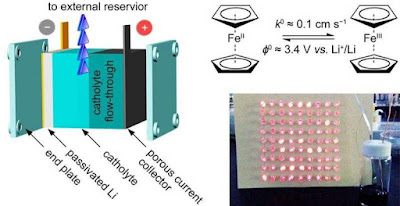“The greatest significance of our work is that we
have designed a semiliquid battery based on a new chemistry. The battery shows
excellent rate capability that can be fully charged or discharged almost within
one minute while maintaining good energy efficiency and reasonable energy
density, representing a promising prototype liquid redox battery with both high
energy density and power density for energy storage”
Assistant
Professor Dr. Guihua Yu at the University of Texas at Austin discussing his
develpement of a Semi-Liquid Battery
Finally, at long last, the developement of Batteries
is finally getting some much needed push by scientists in the Research World
into the 21-st Century.
A research team from the University of Texas at
Austin has recently developed a Semi-Liquid Battery that has the power density
of a super-capacitor and can potentially replace Li-Ion Batteries as reported
in the article “Semiliquid
battery competitive with both Liion batteries and supercapacitors”,
published 23 May 2015, Physorg.
The team consisting of Assistant Professor Dr.
Guihua Yu, along with Dr. Yu Ding and Dr. Yu Zhao recently published their
research in an issue of the Journal Nano
Letters. The battery, which was specifically designed for use in Hybrid
Electric Vehicles and Renewable Energy Storage systems, is composed of a liquid
cathode (-), a solid lithium anode (+) and a liquid ferrocene electrolyte.
The result is a Battery that not only can replace
Li-Ion Batteries due to their similar voltage but has a storage capacity of a
super capacitor and maintains this performance over multiple charge/recharge
cycles. Because of its liquid nature, this won't be coming to smartphones
anytime soon.
So what makes this Liquid Battery stand out?
University
of Texas at Austin Semi-Liquid Battery – Performance by the Numbers
The Researchers semi-liquid battery when constructed
looks like your typical Lead Acid battery as shown below.
 |
The properties of their semi-liquid battery are also
impressive:
1. 1400 W/L
Power Density
2. 40 Wh/L
Energy Density
3. 137 mAh/g
Power Storage Capacity
4. 80%
of capacity after 500 charge/recharge cycles
These figures for Power Density compares well with Super-capacitors
and the Energy Density compares very well most
stateoftheart redox flow batteries and leadacid batteries, lagging
a little behind the performance of Li-Ion Batteries. These figures are
best illustrated on the graph below.
 |
The Energy Density is great for Renewable Energy
Storage and Backup Battery Systems. If their semi-liquid battery were used as a
replacement for Li-Ion Batteries in All-Electric Vehicles, it would improve the
All-Electric Vehicles range. They'd also be able to accelerate quicker due to
the Higher Power Density, which implies an incredibly high current discharge to
power the motors of the vehicle.
Liquid
Gel Batteries in Smartphones – Battery life measured in years and not hours
Work, however, still need to be done on Lithium Ion
Anode, which gradually breaks down over time into the solution ferrocene
solution to quote Dr. Guihua Yu at the University of Texas at Austin: “The potential weakness of this battery is the
lithium anode in terms of longterm stability and safety. More advanced lithium
anode protection is required to fully suppress selfdischarge”.
Zinc and magnesium further down in the
Electrochemical Series are possible replacements, to quote Dr. Guihua Yu at the
University of Texas at Austin: We suppose that other metals like zinc and
magnesium may also function as the anode for such a battery as long as the
electrolyte compatibility is resolved. We also expect that other organometallic
compounds with multivalencestate metal centers (redox centers) may also
function as the anode, which eventually would make the battery fully liquid”.
Increasing the solubility of the ferrocene in order
to increase the Energy Density is a possibility. Liquid Batteries may one day
make smartphone, Tablet and smartwatch batteries that have massive capacities
measured in years not days stored in a safe liquid-gel format. Until then, this
is progress towards Battery Storage measured in years and months and not just days
and hours.
Here’s the link:
No comments:
Post a Comment